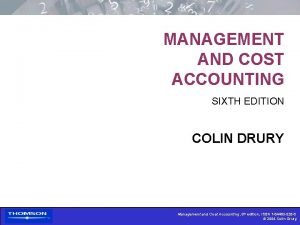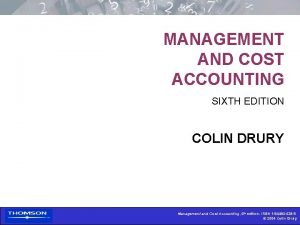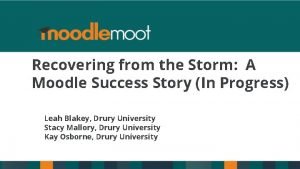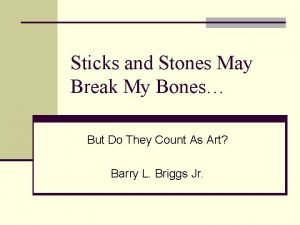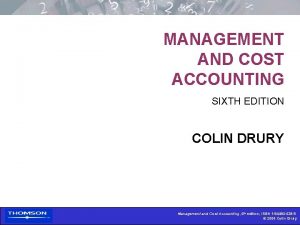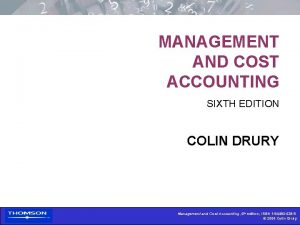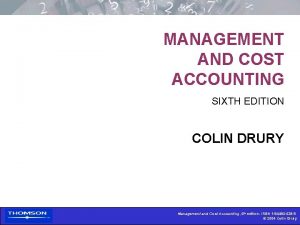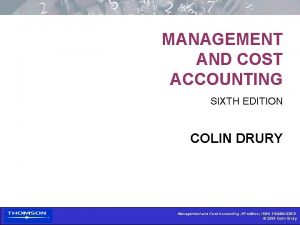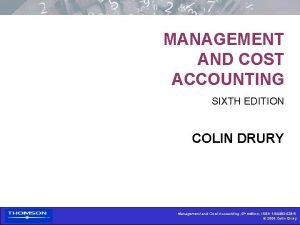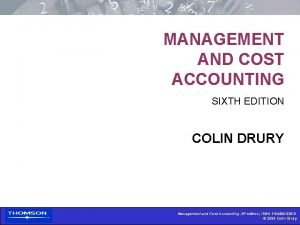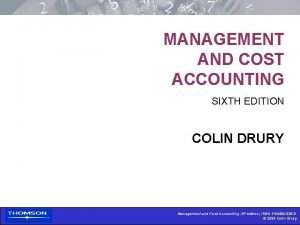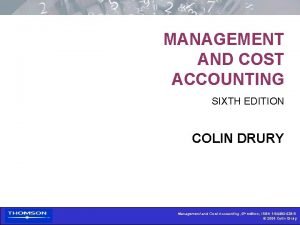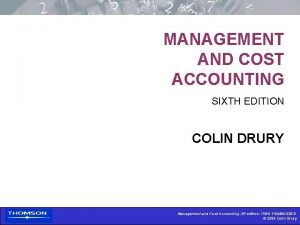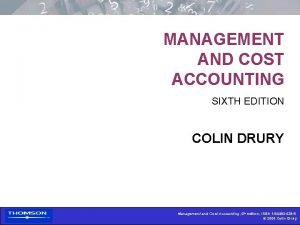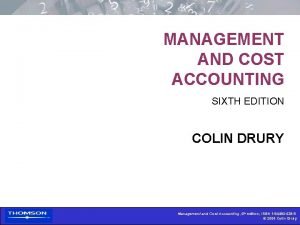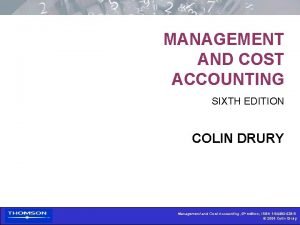MANAGEMENT AND COST ACCOUNTING SIXTH EDITION COLIN DRURY















- Slides: 15

MANAGEMENT AND COST ACCOUNTING SIXTH EDITION COLIN DRURY Management and Cost Accounting, 6 th edition, ISBN 1 -84480 -028 -8 © 2004 Colin Drury

Part Four: Information for planning, control and performance Chapter Fifteen: The budgeting process Management and Cost Accounting, 6 th edition, ISBN 1 -84480 -028 -8 © 2000 Colin Drury © 2004 Colin Drury

15. 1 Fig 15. 1 An overview of the planning process 1. Identify the objectives of the organization. 2. Identify potential strategies. 3. Evaluate alternative strategic options. 4. Select course of action. 5. Implement the long-term plan in the form of the annual budget. 6. Monitor actual results. 7. Respond to divergencies from plan. Management and Cost Accounting, 6 th edition, ISBN 1 -84480 -028 -8 © 2000 Colin Drury © 2004 Colin Drury

15. 2 a Why do we produce budgets? 1. To aid the planning of actual operations: • by forcing managers to consider how conditions might change and what steps should be taken now. • by encouraging managers to consider problems before they arise. 2. To co-ordinate the activities of the organization: • by compelling managers to examine relationships between their own operation and those of other departments. Management and Cost Accounting, 6 th edition, ISBN 1 -84480 -028 -8 © 2000 Colin Drury © 2004 Colin Drury

15. 2 b Why do we produce budgets? 3. To communicate plans to various responsibility centre managers: • everyone in the organization should have a clear understanding of the part they are expected to play in achieving the annual budget. • by ensuring appropriate individuals are made accountable for implementing the budget. 4. To motivate managers to strive to achieve the budget goals: • by focusing on participation • by providing a challenge/target. Management and Cost Accounting, 6 th edition, ISBN 1 -84480 -028 -8 © 2000 Colin Drury © 2004 Colin Drury

15. 2 c 5. To control activities: • by comparison of actual with budget (attention directing/management by exception). 6. To evaluate the performance of managers: • by providing a means of informing managers of how well they are performing in meeting targets they have previously set. Management and Cost Accounting, 6 th edition, ISBN 1 -84480 -028 -8 © 2000 Colin Drury © 2004 Colin Drury

15. 3 Stages in the budgeting process 1. Communicate details of budget policy and guidelines to those people responsible for preparing the budget. 2. Determine the factor that restricts output. 3. Preparation of the sales budget. 4. Initial preparation of budgets. 5. Negotiation of budgets with higher management. (See figure on slide 15. 4) 6. Co-ordination and review of budgets. 7. Final acceptance of budgets. 8. Ongoing review of the budgets. Management and Cost Accounting, 6 th edition, ISBN 1 -84480 -028 -8 © 2000 Colin Drury © 2004 Colin Drury

15. 4 Fig 15. 4 An illustration of budgets moving up the organizational hierarchy. Management and Cost Accounting, 6 th edition, ISBN 1 -84480 -028 -8 © 2000 Colin Drury © 2004 Colin Drury

15. 5 a Activity-based budgeting (ABB) • Conventional budgeting is inappropriate for those activities where the consumption of resources does not vary proportionately with the volume of the final output of products or services. • For support activities conventional incremental budgets merely serve as authorization levels for certain levels of spending. • Incremental budgeting results in the cost of non-unit level activities becoming fixed. • ABB aims to authorize only the supply of those resources that are needed to perform activities required to meet budgeted production and sales volumes. Management and Cost Accounting, 6 th edition, ISBN 1 -84480 -028 -8 © 2000 Colin Drury © 2004 Colin Drury

15. 5 b • The ABB process is the reverse of the ABC process: Budgeted output of cost objects Determine the necessary activities Determine the resources required for the budget period Management and Cost Accounting, 6 th edition, ISBN 1 -84480 -028 -8 © 2000 Colin Drury © 2004 Colin Drury

15. 6 a ABB involves the following stages: 1. Estimate the production and sales volume by individual products and customers. 2. Estimate the demand for organizational activities. (e. g. Process 5, 000 customers’ orders for the customer order processing activity) 3. Determine the resources that are required to perform organizational activities. (e. g. 0. 5 hours per order = 5, 000 × 0. 5 hours = 2, 500 labour hours for the customer processing activity must be supplied) Management and Cost Accounting, 6 th edition, ISBN 1 -84480 -028 -8 © 2000 Colin Drury © 2004 Colin Drury

15. 6 b 4. Estimate for each resource the quantity that must be supplied to meet the demand. (e. g. Assume a step cost function with each person employed contracted to work 1, 500 hours per year so that quantity of resources required = 2, 500/1, 500 =1. 67 persons meaning that 2 persons must be employed) 5. Take action to adjust the capacity of resources to match the projected supply. (e. g If 3 persons are presently employed on the activity resources must be reduced, or redeployed, by one person) Management and Cost Accounting, 6 th edition, ISBN 1 -84480 -028 -8 © 2000 Colin Drury © 2004 Colin Drury

15. 7 a • Periodically actual results should be compared with an adjusted (flexible) budget. Example Budgeted activity for processing orders Orders processed person Resources required Resources supplied (practical capacity for 3, 000 orders) Employment costs (£ 25, 000 person per year) Cost driver rate (£ 125, 000/3, 000 orders) Actual orders processed for the period = 2, 800 orders = 600 = 4. 67 persons = 5 persons = £ 125, 000 = £ 41. 67 = 2, 500 orders Performance report: Flexed budget (2, 500 ×£ 41. 67 ) = £ 104, 175 Budgeted unused capacity (3, 000 — 2, 800)× £ 41. 67 = 8, 334 Unplanned unused capacity (2, 800 – 2, 500)× £ 41. 67 = 12, 491 125, 000 Management and Cost Accounting, 6 th edition, ISBN 1 -84480 -028 -8 © 2000 Colin Drury © 2004 Colin Drury

15. 7 b • Above represent committed resources but for flexible resources (e. g. office supplies) resources supplied can be matched exactly to resources demanded. • See sheet 8 for an illustration of an activity-based budget for an order processing activity. Management and Cost Accounting, 6 th edition, ISBN 1 -84480 -028 -8 © 2000 Colin Drury © 2004 Colin Drury

15. 8 Exhibit 15. 1 Activity-based budget for an order receiving process Management and Cost Accounting, 6 th edition, ISBN 1 -84480 -028 -8 © 2000 Colin Drury © 2004 Colin Drury
 Drury management and cost accounting
Drury management and cost accounting Drury c management and cost accounting
Drury c management and cost accounting Mmodation
Mmodation The sixth sick sheik's sixth sheep's sick lyrics
The sixth sick sheik's sixth sheep's sick lyrics Biochemistry sixth edition 2007 w.h. freeman and company
Biochemistry sixth edition 2007 w.h. freeman and company Drury moodle
Drury moodle Chris drury medicine wheel
Chris drury medicine wheel Craig drury
Craig drury Craig marlatt geography
Craig marlatt geography Computer architecture a quantitative approach sixth edition
Computer architecture a quantitative approach sixth edition Automotive technology principles diagnosis and service
Automotive technology principles diagnosis and service Automotive technology sixth edition
Automotive technology sixth edition Citation sample pdf
Citation sample pdf Computer architecture a quantitative approach sixth edition
Computer architecture a quantitative approach sixth edition Precalculus sixth edition
Precalculus sixth edition Rational people think at the margin
Rational people think at the margin
